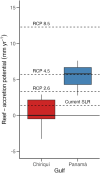Upwelling, climate change, and the shifting geography of coral reef development
- PMID: 36750639
- PMCID: PMC9905564
- DOI: 10.1038/s41598-023-28489-0
Upwelling, climate change, and the shifting geography of coral reef development
Abstract
The eastern tropical Pacific is oceanographically unfavorable for coral-reef development. Nevertheless, reefs have persisted there for the last 7000 years. Rates of vertical accretion during the Holocene have been similar in the strong-upwelling Gulf of Panamá (GoP) and the adjacent, weak-upwelling Gulf of Chiriquí (GoC); however, seasonal upwelling in the GoP exacerbated a climate-driven hiatus in reef development in the late Holocene. The situation is now reversed and seasonal upwelling in the GoP currently buffers thermal stress, creating a refuge for coral growth. We developed carbonate budget models to project the capacity of reefs in both gulfs to keep up with future sea-level rise. On average, the GoP had significantly higher net carbonate production rates than the GoC. With an estimated contemporary reef-accretion potential (RAP) of 5.5 mm year-1, reefs in the GoP are projected to be able to keep up with sea-level rise if CO2 emissions are reduced, but not under current emissions trajectories. With an estimated RAP of just 0.3 mm year-1, reefs in the GoC are likely already unable to keep up with contemporary sea-level rise in Panamá (1.4 mm year-1). Whereas the GoP has the potential to support functional reefs in the near-term, our study indicates that their long-term persistence will depend on reduction of greenhouse gases.
© 2023. The Author(s).
Conflict of interest statement
The authors declare no competing interests.
Figures




References
-
- Allemand D, et al. Biomineralisation in reef-building corals: From molecular mechanisms to environmental control. C. R. Palevol. 2004;3:453–467. doi: 10.1016/j.crpv.2004.07.011. - DOI
-
- Glynn, P. W. Bioerosion and coral-reef growth: A dynamic balance. In Life and Death of Coral Reefs (ed Birkeland, C.) 68–95 (Chapman & Hall, 1997).
Publication types
MeSH terms
Substances
LinkOut - more resources
Full Text Sources

